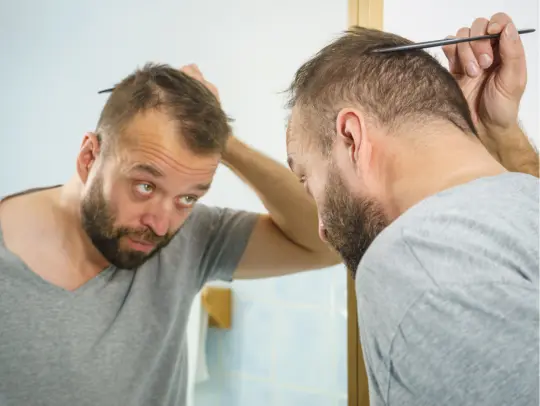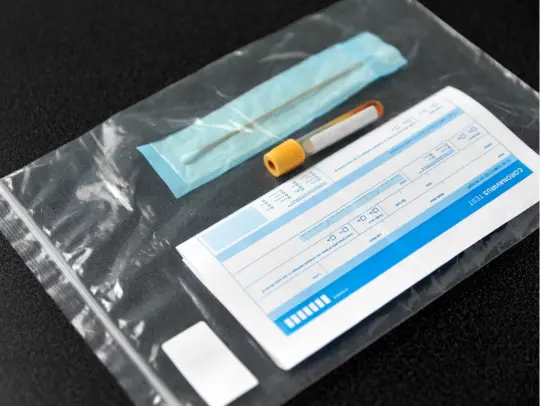
Stages of Hair Loss
Male & Female Hair Loss: Stages, Types & Effective Treatments
So you've noticed more hair in your brush than usual? Or maybe you've spotted your scalp peeking through where lush hair used to be? First things first – you're not alone. Millions of people are in the same boat, wondering: "How bad is my hair loss going to get, and how long before I'm sporting the full cue ball look?"
Good news! Hair loss usually doesn't happen overnight (despite what it might feel like when you find a clump in your shower drain). It's typically a gradual process, and understanding where you are in that journey can help you take the right steps to slow it down or even reverse it.
Did you know? Hair loss affects over 50 million men and 30 million women in the United States alone. That's a lot of people checking their hairlines in the mirror every morning!
Hair Loss 101: How It Typically Shows Up
Hair loss looks different depending on whether you're a guy or gal:
For the Fellas
Men usually notice the classic "M-shape" forming at the hairline (hello, receding temples!) that gradually works its way back. Eventually, this often connects with thinning at the crown, leaving that horseshoe pattern of hair around the sides and back.
For the Ladies
Women typically experience a widening part line and overall thinning at the crown, rather than a receding hairline (though that can happen too, especially after menopause with something called frontal fibrosing alopecia). The good news? Women rarely go completely bald, even with significant hair loss.
Sometimes hair loss shows up in other ways too – circular bald patches, hair coming out in clumps, or even eyebrow and beard thinning. If your scalp feels itchy, painful, or looks unusual before hair falls out, that's a sign to get checked out ASAP.
The "How Bad Is It?" Guide to Male Pattern Baldness Stages
For guys, hair loss typically follows a pretty predictable pattern (thanks, genetics). Here's how to figure out where you are on the balding journey:
- Stage 1: Minimal thinning, maybe a slightly higher hairline, but nothing that would make anyone say "that dude's going bald."
- Stage 2: The M-shape becomes more noticeable as your hairline recedes at the temples.
- Stage 3: Deeper recession at the temples creates a more defined U or V shape at the front.
- Stage 4: Thinning becomes obvious at the crown (that bald spot on the back of your head).
- Stage 5: The receding front and the thinning crown get closer to meeting in the middle, with more visible scalp.
- Stage 6: The bald areas connect to form a larger, continuous bald patch, with a horseshoe/U-shaped hairline.
- Stage 7: Only a band of hair remains around the sides and back of the head – the classic male pattern baldness end stage.
Remember, this process can take decades for some guys, while others speed through the stages faster than you can say "hair transplant." Genetics are the biggest factor in how quickly you'll progress.
The Women's Guide to Hair Loss Patterns
Women's hair loss is a bit sneakier and usually doesn't follow such neat "stages." Instead, here's what typically happens:
- It usually kicks in after 40, with most women noticing by age 50
- Hair thins gradually, starting at the part line
- The part gets wider as more follicles produce thinner, weaker hairs
- Thinning radiates from the top of the scalp
- Hair loss often happens in "bursts" rather than steadily
Women often notice hair loss first when their ponytail feels thinner or they see more scalp when their hair is wet. Another telltale sign? Having to loop that hair elastic around one more time than you used to.
Not All Hair Loss Is Created Equal: Types You Should Know About
There's a whole menu of hair loss conditions beyond the classic pattern baldness. Here are some you might encounter:
Androgenetic Alopecia
The technical name for male and female pattern hair loss. This is the most common type, affecting millions of people, and is related to hormones and genetics.
Telogen Effluvium
This is when a shock to your system (major illness, surgery, extreme stress, crash diet) pushes a bunch of your hair into the shedding phase all at once. You'll notice hair coming out in handfuls, but the good news is this type is usually temporary.
Alopecia Areata
This creates round, completely bald patches that appear suddenly. It's an autoimmune condition where your body essentially attacks your hair follicles. It can progress to more severe forms:
- Persistent Patchy: Ongoing patches that never develop into extensive hair loss
- Alopecia Totalis: Complete loss of all scalp hair
- Alopecia Universalis: Loss of all body hair including eyebrows and eyelashes
- Ophiasis: Hair loss in a band shape around the back and sides of the head
Scarring Alopecias
These types destroy the hair follicle and replace it with scar tissue, making hair loss permanent. These include:
- Lichen Planopilaris: Creates itchy, red, irritated scalp with small bumps
- Frontal Fibrosing Alopecia: Receding hairline in postmenopausal women
- Central Centrifugal Cicatricial Alopecia: Often caused by damaging hair products and styling
- Folliculitis Decalvans: Inflamed, swollen scalp with pustules (pus-filled bumps)
Medical Conditions
Some hair loss is a symptom of other issues:
- Tinea Capitis: A contagious fungal infection requiring antifungal medication
- Discoid Lupus Erythematosus: An autoimmune disease causing skin lesions and scarring
- Anagen Effluvium: Rapid hair loss from chemotherapy or toxin exposure
When to Get Your Hair Loss Checked Out
While some hair loss is a normal part of aging, these signs warrant a trip to the doctor:
- Sudden, rapid hair loss over a short period
- Patchy hair loss or circular bald spots
- Scalp that's red, painful, itchy, or has unusual discharge
- Hair loss accompanied by other symptoms like fatigue or weight changes
- Hair breaking off rather than falling out from the root
- Hair loss that's causing significant emotional distress
Your doctor can help determine if your hair loss is simply genetic or if there's an underlying medical condition that needs treatment. They might do a physical exam, blood tests, or even a small scalp biopsy to figure out what's going on.
Treatments That Can Actually Help
Don't lose hope – there are effective treatments out there for most types of hair loss!
For Pattern Hair Loss (the most common kind):
- Minoxidil (Rogaine): Available over-the-counter and works for both men and women
- Finasteride (Propecia): Prescription pill for men (not for women who may become pregnant)
- Hair transplants: Surgical option that moves hair from the back of your head to thinning areas
- Laser therapy: Low-level light treatments that can stimulate hair growth
For Autoimmune Hair Loss:
- Corticosteroids: Applied to the scalp, injected into bald patches, or taken orally
- Immunotherapy: Creates a mild allergic reaction that can "distract" your immune system
- JAK inhibitors: Newer medications showing promise for severe cases
Nutritional Support:
PeakBody's hair growth supplement contains ingredients that support healthier, stronger hair:
- Biotin: A B-vitamin essential for hair protein production
- Silica: Helps strengthen hair and improve shine
- Collagen: Provides building blocks for hair growth
Take two tablets daily with meals for best results. The formula is non-GMO, GMP certified, and contains no fillers. Many users notice results within a few weeks of consistent use.
Mens Hair Treatment
All Natural Growth Supplement
Hair Growth Supplement treatment for Mens hair. Best ingredients available in any hair growth treatment supplement.Your Price BUY NOW!
Coupon automatically added to your cart
The Takeaway: Don't Panic, Take Action
Hair loss can feel devastating, but remember:
- You're definitely not alone – millions of people deal with thinning hair
- The earlier you address it, the more options you have
- Most hair loss can be slowed, stopped, or even reversed with the right approach
- New treatments are constantly being developed
The days of just accepting baldness as inevitable are over. With proper diagnosis and treatment, you can take control of your hair situation – whether that means keeping what you have, regrowing what you've lost, or simply rocking the bald look with confidence (also a totally valid choice!).
Remember: Hair loss treatments take time to work – typically 3-6 months before you'll see noticeable improvement. Patience and consistency are key!




































































































































